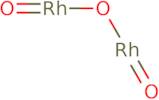rhodium(III) oxide
CAS: 12036-35-0
Rif. 3D-MAA03635
| 1g | Fuori produzione | ||
| 50mg | Fuori produzione | ||
| 100mg | Fuori produzione | ||
| 250mg | Fuori produzione | ||
| 500mg | Fuori produzione |
Informazioni sul prodotto
- Dirhodium Trioxide
- Oxo-(Oxorhodiooxy)Rhodium
- Oxygen(-2) Anion
- Rhodium Sesquioxide
- Rhodium oxide
- Rhodium oxide (Rh<sub>2</sub>O<sub>3</sub>)
- Rhodium oxide (RhO<sub>1.5</sub>)
- Rhodium trioxide
- Rhodium(+3) Cation
- Rhodium(+3)Oxide
- Vedi altri sinonimi
- Rhodium(III) oxide
- Rhodium(Iii) Oxide Anhydrous
- Rhodium(Iii) Oxide, 99.8%
- Rhodiumoxideanhydrousgraypowder
- Rhodium oxide (Rh2O3)
Rhodium(III) oxide (RhO2) is a synthetic compound that belongs to the group of metal oxides. It is made by reacting calcium oxide and monoxide in an electric furnace. The synthesis of rhodium(III) oxide is relatively easy, but it has a low yield. Rhodium(III) oxide reacts with ethylene at high temperatures and pressure to form ethylidene rhodium. This reaction occurs because the C-H bonds are broken in the ethylene molecule, allowing the hydrogen atoms to be replaced with rhodium atoms. This process requires a higher temperature than other methods of synthesizing RhO2 and yields less product than other methods. Rhodium(III) oxide transforms into other compounds through reactions with alcohols, such as ethanol or methanol. The compound changes from a solid state to a liquid state when heated above its melting point, and then back to a solid when cooled below its melting point.





